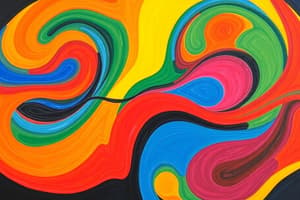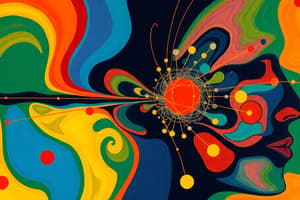Podcast
Questions and Answers
What is the process called that translates sensory information into a form that the nervous system can understand?
What is the process called that translates sensory information into a form that the nervous system can understand?
- Perception
- Transduction (correct)
- Sensory adaptation
- Signal detection
Which taste quality is associated with savory flavors?
Which taste quality is associated with savory flavors?
- Sour
- Umami (correct)
- Bitter
- Sweet
What does the absolute threshold refer to in sensation?
What does the absolute threshold refer to in sensation?
- The minimum intensity of stimulation needed to detect a sensation (correct)
- The maximum intensity of a stimulus that can be detected
- The level of stimulus intensification required to notice a change
- The degree of adaptation to an unchanging stimulus
Which part of the brain is primarily involved in processing the emotional aspects of taste?
Which part of the brain is primarily involved in processing the emotional aspects of taste?
What is the term for the reduced response to an unchanging stimulus?
What is the term for the reduced response to an unchanging stimulus?
How are taste receptors distributed across the tongue?
How are taste receptors distributed across the tongue?
Which of the following best describes psychophysics?
Which of the following best describes psychophysics?
What is the difference threshold?
What is the difference threshold?
What is the primary function of the olfactory epithelium?
What is the primary function of the olfactory epithelium?
How does aging affect taste perception?
How does aging affect taste perception?
Which structure is primarily involved in processing flavor perception?
Which structure is primarily involved in processing flavor perception?
What type of receptors respond specifically to pain?
What type of receptors respond specifically to pain?
What phenomenon may occur when individuals lose a limb?
What phenomenon may occur when individuals lose a limb?
Which type of fibers are responsible for transmitting sharp, immediate pain?
Which type of fibers are responsible for transmitting sharp, immediate pain?
Which of the following correctly describes the organization of touch receptors in the body?
Which of the following correctly describes the organization of touch receptors in the body?
What role does the vestibular system play in the body?
What role does the vestibular system play in the body?
What happens to olfactory receptors over time?
What happens to olfactory receptors over time?
In which area of the brain does the olfactory pathway terminate?
In which area of the brain does the olfactory pathway terminate?
What is primarily responsible for transducing sound energy into neural signals in the inner ear?
What is primarily responsible for transducing sound energy into neural signals in the inner ear?
Which structure of the eye adjusts the size of the pupil in response to light levels?
Which structure of the eye adjusts the size of the pupil in response to light levels?
What is the function of the thalamus in the auditory pathway?
What is the function of the thalamus in the auditory pathway?
Which theory explains that the location of sound frequency corresponds to different areas of the basilar membrane?
Which theory explains that the location of sound frequency corresponds to different areas of the basilar membrane?
What phenomenon allows humans to perceive depth based on the slightly different images received by each eye?
What phenomenon allows humans to perceive depth based on the slightly different images received by each eye?
Which part of the auditory system processes information about sound before it reaches the thalamus?
Which part of the auditory system processes information about sound before it reaches the thalamus?
In the perception of color, which theory states that if one color is activated, its complementary color is inhibited?
In the perception of color, which theory states that if one color is activated, its complementary color is inhibited?
Where does the primary visual cortex receive visual information from?
Where does the primary visual cortex receive visual information from?
Which part of the ear assists in localizing sounds in the vertical plane?
Which part of the ear assists in localizing sounds in the vertical plane?
What type of depth cue uses the relative motion of objects as viewed from different distances?
What type of depth cue uses the relative motion of objects as viewed from different distances?
In which part of the brain is the Fusiform Face Area (FFA) primarily located?
In which part of the brain is the Fusiform Face Area (FFA) primarily located?
What does the closure principle of Gestalt psychology describe?
What does the closure principle of Gestalt psychology describe?
How does the lens of the eye adjust its shape for focusing on distant objects?
How does the lens of the eye adjust its shape for focusing on distant objects?
Which type of cells in the retina are responsible for color vision?
Which type of cells in the retina are responsible for color vision?
Flashcards
Transduction
Transduction
The process of transforming sensory stimuli into neural signals that the brain can understand.
Absolute Threshold
Absolute Threshold
The minimum intensity of a stimulus that must occur before a person can detect it 50% of the time.
Difference Threshold (Just Noticeable Difference)
Difference Threshold (Just Noticeable Difference)
The smallest detectable difference between two stimuli. It's the amount of change needed to notice a difference 50% of the time.
Psychophysics
Psychophysics
Signup and view all the flashcards
Gustation
Gustation
Signup and view all the flashcards
Papillae
Papillae
Signup and view all the flashcards
Taste Buds
Taste Buds
Signup and view all the flashcards
Cilia (Taste Receptors)
Cilia (Taste Receptors)
Signup and view all the flashcards
Olfactory Epithelium
Olfactory Epithelium
Signup and view all the flashcards
Olfactory Bulb
Olfactory Bulb
Signup and view all the flashcards
Olfaction
Olfaction
Signup and view all the flashcards
Flavor Perception
Flavor Perception
Signup and view all the flashcards
Mechanoreceptors
Mechanoreceptors
Signup and view all the flashcards
Sensory Homunculus
Sensory Homunculus
Signup and view all the flashcards
Gate Control Theory of Pain
Gate Control Theory of Pain
Signup and view all the flashcards
Vestibular System
Vestibular System
Signup and view all the flashcards
Phantom Limb
Phantom Limb
Signup and view all the flashcards
Somatosensation
Somatosensation
Signup and view all the flashcards
Pain Pathways
Pain Pathways
Signup and view all the flashcards
Sound Waves
Sound Waves
Signup and view all the flashcards
Outer Ear Function
Outer Ear Function
Signup and view all the flashcards
Middle Ear Function
Middle Ear Function
Signup and view all the flashcards
Inner Ear Function
Inner Ear Function
Signup and view all the flashcards
Hair Cell Activation
Hair Cell Activation
Signup and view all the flashcards
Pitch Perception Theories
Pitch Perception Theories
Signup and view all the flashcards
Accommodation
Accommodation
Signup and view all the flashcards
Cornea Function
Cornea Function
Signup and view all the flashcards
Iris Function
Iris Function
Signup and view all the flashcards
Lens Function
Lens Function
Signup and view all the flashcards
Photoreceptor Function
Photoreceptor Function
Signup and view all the flashcards
Visual Pathway Streams
Visual Pathway Streams
Signup and view all the flashcards
Visual Information Transmission
Visual Information Transmission
Signup and view all the flashcards
Gestalt Principles of Perception
Gestalt Principles of Perception
Signup and view all the flashcards
Depth Perception
Depth Perception
Signup and view all the flashcards
Study Notes
Sensation and Perception
- Sensation: The detection of external stimuli (e.g., light, pressure) and transmission of that information to the brain.
- Stimulus: Anything triggering a reaction from sensory systems.
- Transduction: Converting sensory information into a format the nervous system understands.
- Perception: Processing, organizing, and interpreting sensory signals, resulting in a conscious experience of stimuli.
- Sensory Adaptation: Reduced response to unchanging stimuli.
- Psychophysics: Studies the relationship between physical stimuli and subjective responses.
- Absolute Threshold: Minimum stimulus intensity for detection.
- Difference Threshold: Smallest detectable difference between two stimuli (just noticeable difference).
- Signal Detection: Analysis of sensory and decision-making processes in detecting faint stimuli.
Gustation (Taste)
- Basic Taste Qualities: Sweet, salty, sour, bitter, and umami (savory).
- Taste Experience: Taste experience occurs in the brain, influenced by smell and texture.
- Taste Receptors: Located on the tongue and mouth, including receptors sensitive to carbohydrates and capsaicin (hot peppers).
- Papillae: Bumpy structures on the tongue containing taste buds.
- Taste Buds: Structures containing taste receptor cells, which interact with dissolved taste stimuli.
- Taste Pathway: Information travels from mouth and tongue to the medulla, then thalamus, and finally to the insula and orbitofrontal cortex for processing pleasantness/unpleasantness.
Olfaction (Smell)
- Olfactory Epithelium: Thin tissue layer in the nasal cavity with smell receptors.
- Olfactory Receptors: Transmitting information to the olfactory bulb (brain's smell center).
- Olfactory Pathway: Information from the olfactory bulb travels to the olfactory cortex, amygdala, and other areas.
- Olfactory Receptors' Life Cycle: Regularly die and are replaced.
Touch
- Somatosensation: Body senses, including body position, touch, temperature, & pain.
- Mechanoreceptors: Respond to mechanical pressure.
- Pain Reception: Activated by damaging stimuli; myelinated fibers for sharp pain, and unmyelinated for dull.
- Nocioreceptors: Pain receptors.
- Gate Control Theory: Spinal cord can "gate" pain signals to the brain (opening or closing).
- Phantom Limb Phenomenon: Pain from a missing limb due to cortex reorganization.
- Vestibular System (Inner Ear): Provides information about body position and movement.
Audition (Hearing)
- Sound Waves: Sound created by vibration, frequency (pitch), and amplitude (loudness).
- Human Hearing Range: 20 Hz to 20,000 Hz.
- Parts of the Ear: Outer (pinna, auditory canal), middle (eardrum, ossicles), inner (cochlea).
- Cochlea: Fluid-filled structure in the inner ear containing hair cells.
- Organ of Corti: Contains hair cells that transduce sound vibrations into neural signals.
- Auditory Nerve: Carries sound information to the brain.
- Auditory Pathways: Sound info travels from the cochlea to the medulla, midbrain, thalamus, and then to the primary auditory cortex.
- Pitch Perception: Place theory (different parts of the basilar membrane respond to different frequencies) and temporal theory (neural firing rate matches sound frequency).
Vision
-
Accommodation: Changing lens shape to focus on near/distant objects.
-
Photoreceptors: Rods and cones convert light energy to electrical signals.
-
Trichromatic Theory: Color perception based on 3 types of cones (red, green, blue).
-
Opponent-Process Theory: Colors are processed in opposing pairs (red/green, yellow/blue, white/black).
-
Rods: Specialized for low-light vision (black and white).
-
Cones: Specialized for high-light vision and color.
-
Visual Pathways: Light information travels from retina, through optic nerves, optic chiasm, optic tracts, thalamus (to the amygdala and primary visual cortex).
-
Primary Visual Cortex (V1): Processes basic visual features.
-
Dorsal Stream: Spatial perception (where).
-
Ventral Stream: Object recognition (what).
-
Gestalt Principles: Figure-ground, proximity, similarity, continuity, closure, illusory contours.
-
Depth Perception: Retinal disparity, monocular cues (occlusion, relative size, etc), motion parallax.
-
Bottom-up Processing: Processing based on sensory input.
-
Top-down Processing: Processing influenced by prior knowledge.
-
Visual Agnosia/Prosopagnosia: Difficulties with object recognition or face recognition.
-
Fusiform Face Area (FFA): Brain area specialized for face recognition.
Studying That Suits You
Use AI to generate personalized quizzes and flashcards to suit your learning preferences.




